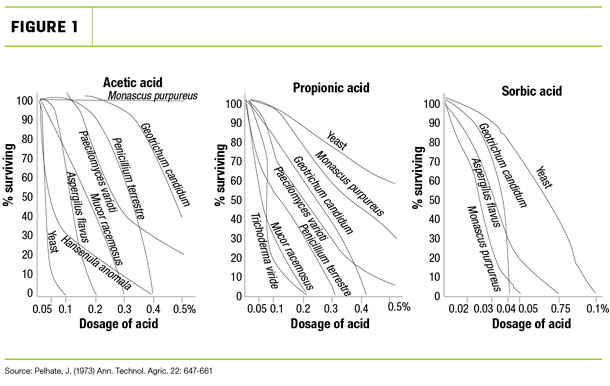Since many of the growing conditions that cause heavy loads of molds, mycotoxins and wild yeast are uncontrollable, this article will focus on how to manage the challenge during the storage process.
Mold and yeast can grow very rapidly. Since both organisms are aerobic, requiring oxygen to grow, the key to preventing extended growth is focusing on eliminating and controlling oxygen during storage. Table 1 illustrates how quickly molds and yeasts can grow.

Mycotoxins are a secondary metabolite produced by mold. Secondary simply means they are not essential for the mold to survive. Therefore, a high mold count does not necessarily correlate to a high mycotoxin load and vice-versa. Mycotoxins may be in the corn silage, but they are not typically associated with unstable feed. The goal is to prevent mold growth during storage, thereby eliminating additional mycotoxin concentration.
Because these organisms and byproducts impact animal health, it is critical to prevent further growth during the storage process. Reduced feed intake; inconsistent manure; and respiratory, metabolic and reproductive disorders are just a few of the health problems animals may face by ingesting compromised feedstuffs.
How corn silage becomes unstable
- High yeast populations are ensiled at the time of harvest.
- Once oxygen has expired in a properly stored environment, the yeast become dormant.
- At feedout, yeasts are re-energized by the introduction of oxygen.
- Yeast grows exponentially, consuming lactic acid.
- Excessive heat is produced, creating an unstable, unpalatable feed.
- As the lactic acid is consumed and volatilized, the silage pH rises.
- Molds prefer the higher pH and begin to grow very rapidly.
- The result is massive spoilage.
This situation can happen in hours if not managed properly. Incorporating storage and feedout best management practices (BMPs) are the key to controlling the proliferation of molds and yeasts during this time period. Monitoring temperature has often been used to identify storage and feedout challenges. Keep in mind, heat can dissipate very rapidly when feed is being moved and mixed.
Therefore, this should not be the only tool used to determine if secondary microbial growth is occurring. If the feed is excessively hot to the touch, too much nutrient loss has already occurred. The bottom line is: Once oxygen has been reintroduced to the forage mass, secondary microbial growth has begun, and managing the rate of growth is now the objective.
All BMPs should focus on controlling oxygen penetration during the storage and feedout process.
Storage and feedout BMPs
- Avoid removing excessive cover plastic prior to feedout. (Removing cover plastic presents some safety challenges. Consider a safety harnessing system for anyone approaching the edge of the silage face.)
- Maintain a smooth feedout face at all times.
- Proper feedout face removal equipment such as mechanical facers or rakes should be considered. This will improve face removal efficiency and the ability to maintain a smooth face.
- Avoid using large equipment with a bucket that can dig into the pile, creating cracks causing excessive air penetration.
- Remove 6 to 12 inches per day in cold weather and at least 12 inches during warm weather. (Yeast and mold organisms can and will proliferate in cool temperatures but are much more aggressive in warmer temperatures. In very large bunkers and piles, this may require “splitting” or taking more than a single cut. This will create a second side face, which will cause some feedout shrink when the second cut is taken.)
- Do not remove more feed than what can be mixed and delivered in a four-hour period.
- Do not pile unstable silage for feeding at a later time or date.
- Discard any visibly moldy feed.
Preventing nutrient degradation in the feedbunk
Research data indicates it is more economical to control yeast growth at the storage facility than after the fact at the TMR. That said, there are many situations in which utilizing a bunk life stabilizer does provide a significant return on investment. There are numerous commercial products available today. It is important to choose a product formulated with ingredients that control yeast growth.
As mentioned above, yeast are lactate consumers. As they consume the lactic acid produced during the fermentation process, the pH in the feed increases. As the pH increases, the molds become more aggressive. Controlling yeast growth indirectly controls mold growth. Figure 1 indicates which organic acids best control yeast growth in aerobic conditions.

There are numerous factors that will determine treatment rate of a commercial bunk life stabilizer: temperature, humidity, volume of other high-moisture feed ingredients, quantity and quality of high-moisture byproducts, corn particle size and moisture, mold, yeast and mycotoxin load, bunker or silo face removal rate, stability of the feed being mixed into the TMR and bunk life expectancy rate (how long the feed needs to remain stable in the feedbunk).
For example, if silage or high-moisture corn is unstable (warm or even hot) at the time of mixing into the TMR, high levels of additives (4 to 6 pounds per ton of TMR) may be required to prevent further nutrient degradation in the feedbunk.
Bunk life stabilizers can also be used very successfully for short-term use as well. For example, during a significant heat and humid event, it is recommended to treat aggressively at a high rate until cooler, less humid conditions return. The economic impact of treating during such events will extend beyond the event itself, as animal performance is much more stable during the event and after the event as well.
The goal of feeding corn silage is to ensure the nutrients are available at the time of feeding. Since yeast is common in corn silage, it is important to incorporate storage and feedout BMPs. ![]()

-
Troy Brown
- Forage Product Line Manager
- Formafeed









